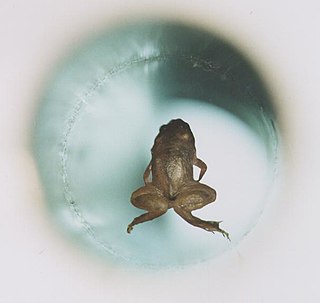
The Ig Nobel Prize is a satirical prize awarded annually since 1991 to celebrate ten unusual or trivial achievements in scientific research. Its aim is to "honor achievements that first make people laugh, and then make them think." The name of the award is a pun on the Nobel Prize, which it parodies, and on the word "ignoble".

National Lampoon was an American humor magazine that ran from 1970 to 1998. The magazine started out as a spinoff from The Harvard Lampoon.

In academic publishing, a scientific journal is a periodical publication designed to further the progress of science by disseminating new research findings to the scientific community. These journals serve as a platform for researchers, scholars, and scientists to share their latest discoveries, insights, and methodologies across a multitude of scientific disciplines. Unlike professional or trade magazines, scientific journals are characterized by their rigorous peer review process, which aims to ensure the validity, reliability, and quality of the published content. With origins dating back to the 17th century, the publication of scientific journals has evolved significantly, playing a pivotal role in the advancement of scientific knowledge, fostering academic discourse, and facilitating collaboration within the scientific community.

The Annals of Improbable Research (AIR) is a bimonthly magazine devoted to scientific humor, in the form of a satirical take on the standard academic journal. AIR, published six times a year since 1995, usually showcases at least one piece of scientific research being done on a strange or unexpected topic, but most of their articles concern real or fictional absurd experiments, such as a comparison of apples and oranges using infrared spectroscopy. Other features include such things as ratings of the cafeterias at scientific institutes, fake classifieds and advertisements for a medical plan called HMO-NO, and a very odd letters page. The magazine is headquartered in Cambridge, Massachusetts.

Timely Comics is the common name for the group of corporations that was the earliest comic book arm of American publisher Martin Goodman, and the entity that would evolve by the 1960s to become Marvel Comics.

Datamation is a computer magazine that was published in print form in the United States between 1957 and 1998, and has since continued publication on the web. Datamation was previously owned by QuinStreet and acquired by TechnologyAdvice in 2020. Datamation is published as an online magazine at Datamation.com.

Norman Sperling is an author, editor, publisher, teacher, and telescope designer living in San Mateo, California.

Melissa Eve Bronwen Franklin is a Canadian experimental particle physicist and the Mallinckrodt Professor of Physics at Harvard University. In 1992, Franklin became the first woman to receive tenure in the physics department at Harvard University and she served as chair of the department from 2010 to 2014. While working at Fermi National Accelerator Laboratory in Chicago, her team found some of the first evidences for the existence of the top quark. In 1993, Franklin was elected a fellow of the American Physical Society. She is a member of the CDF (Fermilab) and ATLAS (CERN) collaborations.

Marc Abrahams is the editor and co-founder of Annals of Improbable Research, and the originator and master of ceremonies of the annual Ig Nobel Prize celebration. He was formerly editor of the Journal of Irreproducible Results.

Regina Barreca is an American academic and humorist. She is a Board of Trustees Distinguished Professor of English literature and feminist theory at the University of Connecticut and winner of UConn's highest award for excellence in teaching. She is the author of ten books, including the best selling They Used to Call Me Snow White But I Drifted: Women's Strategic Use of Humor (Viking/Humor) and editor of 13 others. Her work has appeared in The New York Times, The Independent of London, The Chronicle of Higher Education, Cosmopolitan, and The Harvard Business Review; for 20 years she wrote columns for various Tribune newspapers as well as a series of cover stories for the Chicago Tribune. She is a member of the New York Friar's Club and an honoree of the Connecticut Women's Hall of Fame.

Parody science, sometimes called spoof science, is the act of mocking science in a satirical way. Science can be parodied for a purpose, ranging from social commentary and making political points, to humor for its own sake.

Speculative Grammarian is the self-described "premier scholarly journal featuring research in the neglected field of satirical linguistics". It is a parody science journal, similar in nature to the Annals of Improbable Research or the Journal of Irreproducible Results, but with content focusing on linguistics and closely related fields. It has also been compared to The Onion, but "for linguists."

Ed Subitzky, full name Edward Jack Subitzky, is an American writer and artist. He is best known as a cartoonist, comics artist, and humorist. He has worked as a television comedy writer and performer, a writer and performer of radio comedy, and a writer of radio drama. He has also created comedy and humor in other media. Subitzky is a member of the Screen Actors Guild-American Federation of Television and Radio Artists, and the Writers Guild of America.
Eugene B. Borowitz was an American leader and philosopher in Reform Judaism, known largely for his work on Jewish theology and Jewish ethics. He also edited a Jewish journal, Sh'ma, and taught at the Hebrew Union College-Jewish Institute of Religion.

Harry Jeannot Lipkin, also known as Zvi Lipkin, was an Israeli theoretical physicist specializing in nuclear physics and elementary particle physics. He is a recipient of the prestigious Wigner Medal.
Rejecta Mathematica was an online journal for publishing papers that had been rejected by other mathematics journals. Each paper was accompanied by an open letter describing why the paper was rejected, how the topic has been developed since and why it is worthy of publication. The first issue was published in July 2009 containing topics such as image enhancement and condition numbers. The quality of the contributions in the first issue was seen as mixed. The editors were Michael Wakin, Christopher Rozell, Mark Davenport and Jason Laska.
Scientific Research Publishing (SCIRP) is a predatory academic publisher of open-access electronic journals, conference proceedings, and scientific anthologies that are considered to be of questionable quality. As of December 2014, it offered 244 English-language open-access journals in the areas of science, technology, business, economy, and medicine.

A Journal of Natural Philosophy, Chemistry, and the Arts, generally known as Nicholson's Journal, was the first monthly scientific journal in Great Britain. William Nicholson began it in 1797 and was the editor until it merged with another journal in January 1814.
Scott Sandford is an American astronomer and NASA scientist. He has studied meteorites and other specimens that travel through outer space. Sandford has also written for the science humor magazine Annals of Improbable Research.
Journal of Polymorphous Perversity is a satirical magazine about psychology, established and published by American psychologist Glenn Ellenbogen. Between 1984 and 2003, a total of 40 issues were published, with articles written by professionals and lay people. There are four published collections of articles: Oral Sadism and the Vegetarian Personality (1987), The Primal Whimper (1989), Freudulent Encounters (1992), and More Oral Sadism And The Vegetarian Personality (1996).














